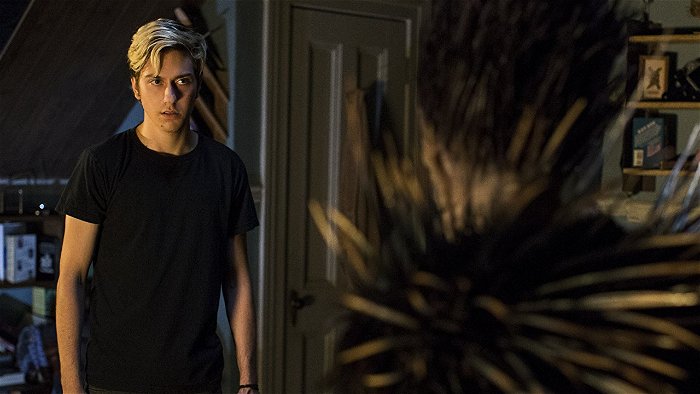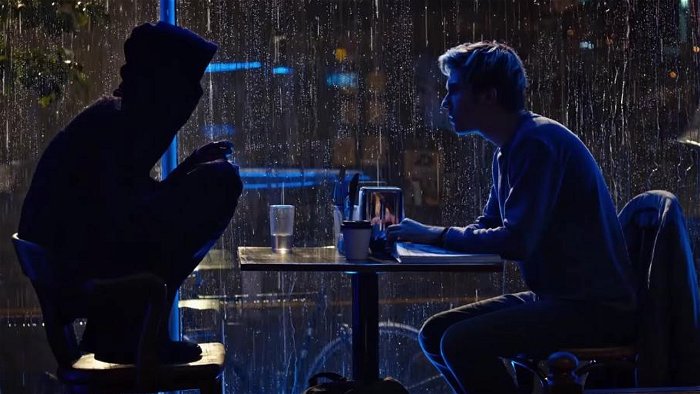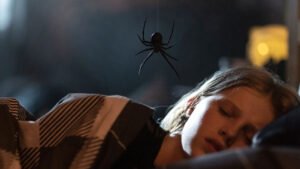Here’s a weird sentence that’ll soon become a new normal: the biggest movie opening this week debuts on Netflix. Adapted from a popular manga (which has already spawned an anime series and live action film franchise in Japan), Death Note should hit screens as a nerd culture wet dream. It’s a project too deranged for the studio system that’s been given a glossy production through Netflix with cult filmmaker Adam Wingard (You’re Next, The Guest) at the helm. Unfortunately, the story was also localized to America, so like the long awaited Ghost In The Shell blockbuster, Death Note stumbles into release hop-scotching through accusations of white-washing.

To deal with that icky controversy up front: yes, this is undeniably quite a Japanese story told in an American setting and that’s a bit awkward. However, for the sake of not letting that overwhelm everything else about Netflix’s Death Note feature, I’m going to leave that criticism there and move onto judging the movie on its own terms. There’s certainly plenty to like about what has been done with Death Note. It’s not a perfect adaptation, but it is a wild genre romp well worth taking in with reasonable expectations. Plus it’s not as if more faithful adaptations of the movie exist if that’s what you want.
Condensing much of the source material into a single film, Death Note U.S.A. stumbles a bit from convoluted plotting in an attempt to cram in as many popular story beats and characters as possible. The basics are the same. There’s a troubled high school kid named Light (Nat Wolff) who stumbles upon notebook called Death Note connected to a death god named Ryuk (Willem Dafoe, perfect casting). If Light writes a name in the book, that person dies. Light soon teams up with a classmate named Mira (Margaret Qually) and together they use the book to murder warlords and criminals under the name Kira. At first, Kira is considered somewhat of a controversial hero by the media thrilled by the bizarre vigilante heroism. Unfortunately, the whole murder thing is a sticky wicket for masked detective L (Lakeith Stanfield), who relentlessly hunts down this mysterious Kira figure and is determined to stop the madness. It goes without saying that this isn’t exactly a story that will end well.

As you may have gathered, Death Note bites off far more than it can chew story-wise. The script either seems to race by at an impossible clip or waste time inching along through minor details. Still, Winguard is embracing momentum and mood over logic. So, at least things are never dull. The man who previously specialized in clever and fairly small horror projects embraces his sudden influx of resources to deliver a film that is—if nothing else—a wild ride. The deaths caused by the notebook are reinvented into Final Destination-style Rube Goldberg death traps delivered with a brand of heightened gruesomeness that should please any horror fan. It’s certainly a gory and unpredictable romp laced with shades of dark humour and a soundtrack designed to feel like a lost 80’s genre epic. At its best, the movie is an almost surrealist explosion of twisted entertainment. It’s clearly been designed with an eye to appealing to the cult audience who have adored the Death Note series for years. They likely would have held a soft spot for the flick in their hearts as well, were it not for the fact that the movie comes from such popular source material and not only rewrites mythology (such as making it so that the Death Note will return to Ryuk’s power if not used every seven days), but also downplays the themes of the series.
It also doesn’t help that the lead actors Nat Wolff and Margaret Qually are the embodiment of a dull and bland Hollywood leads. Both are decent performers and magazine cover pretty, but they don’t have the script or the talent to deliver particularly memorable or distinct protagonists. They are just pretty, mildly troubled heroes that the film’s insanity happens around rather than active and intriguing driving forces. Thankfully, the supporting roles are better cast. Lakeith Stanfield is amusing and intimidating as the determined super detective K and best of all Willem Dafoe was cast perfectly as the demonic Ryuk. Dafoe’s slithering voice perfectly sends chills down the spine and the effects team beautifully recreate the character’s original look, while cleverly concealing Ryuk in shadows so that only the light from his beady eyes pops out from the darkness. The character is as horrifying as fans could hope for, and if Netflix decides to continue produce Death Note movies; at least Ryuk is strong enough to withstand another chapter.

Ultimately Death Note is a mildly disappointing if hardly disastrous adaptation of the popular manga. That won’t be enough for fans, but the uninitiated should get a kick out of the ideas and stylistic excess. Personally, I’m not a huge Death Note fan, so the changes didn’t bother me. I am, however, a huge fan of Adam Wingard’s filmmaking, and it was a blast to see the director cut loose with a decent budget and deliver horror set pieces that would inspire laughs, cheers, and gags in a theater were it not for the Netflix debut. Death Note is certainly nasty, insane, and relentlessly paced enough to keep those who like Hard-R entertainment happy. There are extraordinary set pieces throughout, including a lovingly ludicrous climax on a Ferris wheel that probably helped Wingard land his next job directing Godzilla Vs. King Kong. This isn’t a perfect movie, and it is certainly one destined to be used as an example of Hollywood getting manga adaptations wrong. However, if you can distance yourself enough from the original Death Note to take it on its own terms, Wingard has delivered a pleasing mixture between anime insanity and 80’s genre movie romps. That’s a pretty damn entertaining concoction, even if it’s a disappointing adaptation of Death Note.




